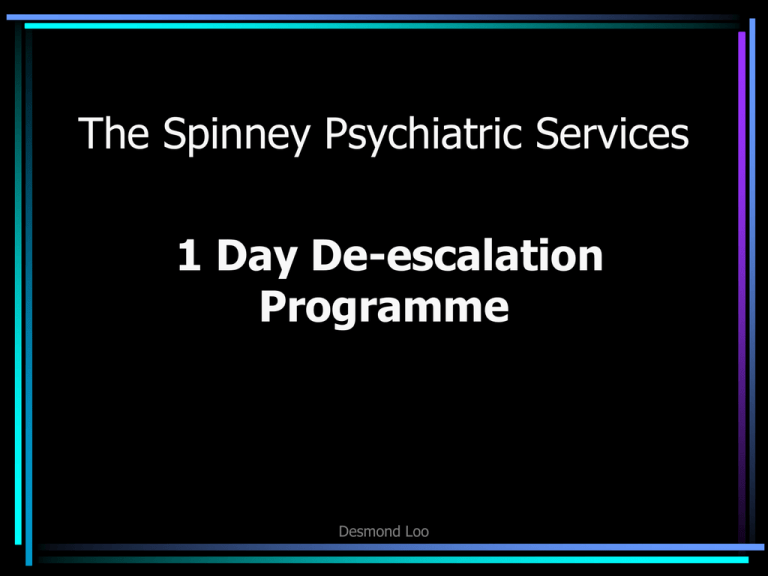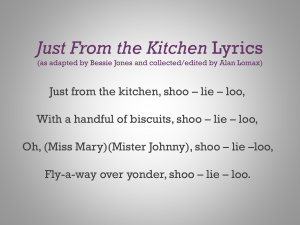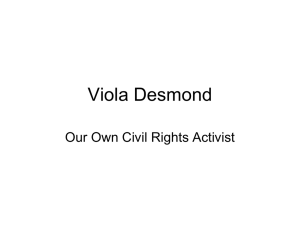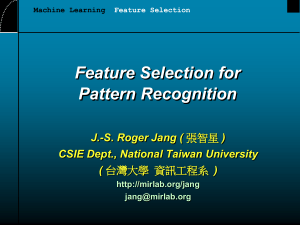Deescalation
advertisement

The Spinney Psychiatric Services 1 Day De-escalation Programme Desmond Loo Introduction • • • • • • Facilitators Facilities Fire exits Toilets Refreshments Breaks Desmond Loo Ice Breaker To start the course proper we will start with an exercise. Desmond Loo Aims • Management of aggression in health care settings • Permissible forms of control • Organisational issues • Increase confidence Desmond Loo Objectives • Raise knowledge concerning aggressive/violent behaviours • Examine own feelings and attitudes towards people who exhibit such behaviours • Recognise triggers which cause aggression • Identify ways to reduce aggression • Learn strategies for dealing with aggression and violence • Understand the main laws, policies and guidelines in respect to work setting Desmond Loo Violence • • • • • Extreme end of spectrum Causes damage, destruction or injury Abuse, threats or assaults at work Who is at risk? Is it MY concern? Desmond Loo Legal Requirement • Section 2(1) of the Health and Safety at Work Act 1974 • Management of Health and Safety at Work Regulations 1999 • UKCC (1996) • The Spinney Policy Manual Desmond Loo What the Law Requires • The Management of Health and Safety at Work Regulations 1999 • The Reporting of Injuries, Diseases and Dangerous Occurrences Regulations 1995 (RIDDOR) • Safety Representative and Safety Committees Regulations 1977 • Health and Safety (consultation with employees) Regulations 1996 Desmond Loo Violence to Staff in Health Care • Health service advisory committee 1987 survey 1. 2. 3. 4. Major injuries Minor injuries No physical injury due to threats Verbal abuse Desmond Loo Mezey & Shepherd (1997) • Primary health care and A & E increased assaults • Increased injuries to nursing staff • Increased injuries to junior doctors, support workers and student nurses Desmond Loo Health Service Advisory Committee 1997 • • • • • Training Causes of violence Warning signs Interpersonal skills Incident reporting Desmond Loo Violence in Mental Health Care UKCC 2001 • Violence directed towards anyone is unacceptable. • Recognition, prevention and management of violence • A need for appropriate training Desmond Loo Break Desmond Loo Reasonable Force (Definition) “ Reasonableness means, firstly, that the force should be no more than is necessary to accomplish the object for which it is allowed (so retaliation and punishment are not permitted) secondly, the reaction must be in proportion to the harm that it is threatened… obviously, the greater the severity of the threatened anger, the more reasonable it is to take tougher action” Dimond (1995) Desmond Loo Reasonable Force (Principles) • • • • Assessment Assessing reasonable force Rule of engagement There must always be a resolution Desmond Loo Use of Force • Lord Griffiths ……… • Section 3 criminal law act 1967 Desmond Loo Scenario 1 • Exercise on the use of force and what is reasonable • Justification of actions • Correct documentation Desmond Loo Review scenario 1 • Discussions on the scenario on the use of force. Desmond Loo Body`s Autonomic Response • • • • Outward non-verbal cues Indication of person aroused Bodily responses to threat and stress These come in a variety of forms Desmond Loo Responses • • • • • • Clenched fists, teeth and muscles Wrinkled brow, frowning Lack of eye contact Invading personal space Hands on hips, provocative movements Square on, confrontational Desmond Loo Responses • Flushed, pale or blotchy complexion • Pacing, foot tapping, page flicking Desmond Loo Group work • Divide into three groups and brainstorm to find definitions of the following 1. Anger 2. Aggression 3. Violence Desmond Loo Lunch Break Desmond Loo Anger • • • • • Emotional response Disrupts thinking Disrupts problem solving Intense irritation Motivation Desmond Loo Aggression • • • • Outward act Acceptable Physical, verbal, mental and passive Difficult to define barrier Desmond Loo Violence • • • • • Extreme end Great force Damaging Physical and mental Two kinds Desmond Loo Manifestations • • • • Thoughts Feelings Actions Bodily functions Desmond Loo Aggression in Healthcare Desmond Loo Triggers Personal factors • Genetic/constitutional/physiological • Personality • Attitude Desmond Loo Triggers External factors • Frustration • Powerlessness • Threat • Fear • Provocation/abuse Desmond Loo Assault Cycle • • • • • Trigger Escalation Crisis Plateau Post crisis Desmond Loo Assault Cycle Chart Desmond Loo Baseline Behaviour • • • • • Normal behaviour Settled Feeling in control Different from person to person Maslow`s(1970) hierarchy of needs Desmond Loo Trigger • • • • • • A shift from baseline Enforced socialisation Lack of choice Lack of privacy Lack of autonomy Trigger reduction Desmond Loo Escalation • • • • Deviates more from baseline Over focused Early intervention Non verbal cues Desmond Loo Crisis • Physically, emotionally and psychologically more aroused • Direct assault likely • Focus on own safety • Intervention of physical restraint (preemptive) Desmond Loo Plateau • • • • High arousal slowly returns to baseline Adrenaline and glucose levels remain Possible further risk of assault Interventions similar to escalation phase Desmond Loo Post Crisis • • • • • • Fall below the base line Physically and mentally exhausted Remorseful Need support Time to explore Comprehensive documentation Desmond Loo Role Plays • There will be a series of role plays to be presented with your participation to illustrate the interventions at various stages of the cycle. Desmond Loo Break . Desmond Loo Assault Cycle Chart Desmond Loo Self positioning • • • • • • • • Clear exits Angled sitting position Ready for departure Hand gestures Distance Not standing over person Tone of voice Peripheral vision Desmond Loo Questions and Answers • A little question and answer sheet for you to participate in Desmond Loo Feedback and Evaluation • Verbal • Written Desmond Loo References • Department of health and welsh office (1993). Code of practice: mental health act 1983. London HMSO • Department of Health Guidelines HC(72)11 : Dealing with violence in the hospital setting • Dimond, B. (1990). Legal aspects of nursing. London: prentice-hall. Desmond Loo References • Health and safety at work act (1974). London HMSO. • Kaplan, S. G., & Wheeler, E. G. (1983). Survival skills for working with potentially violent clients. Social casework: the journal of contemporary social work. Desmond Loo References • Farrell,G.A. & Gray,C.(1992). Aggression, A Nurses guide to Therapeutic Management, London, Scutari Press • Health and Safety at Work Act 1974 Section 2(1) • Hogan, G (1995) Care and Responsibility the Legal Framework, Ashworth Hospital handout. Desmond Loo References • Maslow, A (1970) The farther reaches of human nature, New York: The Viking press. • The Spinney Policy Manual 2002 • UKCC (2001) The recognition, prevention and therapeutic management of violence in mental health care. Desmond Loo Home time . Desmond Loo Zero Tolerance The NHS zero tolerance statement has two principal targets. They are: • Public • Staff Desmond Loo Zero Tolerance – Public To get over to the public that violence against staff working for the NHS is unacceptable. The government and the NHS are determined to stamp it out. Desmond Loo Zero Tolerance - Staff To get over to all staff that violence and intimidation is unacceptable and is being tackled. Desmond Loo Zero Tolerance – Survey 1998 • 3/1000 incidents every month in acute hospitals • 7/1000 incidents every month in ambulance services • 14/1000 incidents every month in community settings • 24/1000 incidents every month in learning difficulties/mental health units Desmond Loo Zero Tolerance Targets • • • • Record Publish Reduction Police Desmond Loo European Human Rights Act 1998 • 1. 2. 3. • Article 2 - A right to life Para 3.14 Para 3.15 Para 3.16 Article 3 - freedom form torture or inhumane or degrading treatment 1. Para 3.24 2. Para 3.25 • Article 5 – personal freedom Desmond Loo








